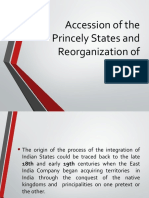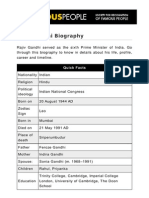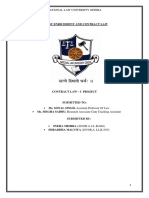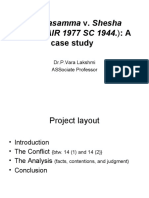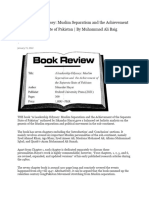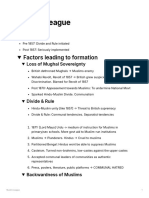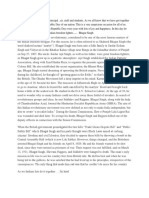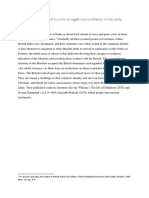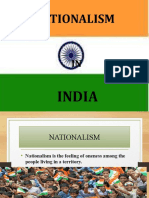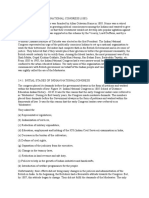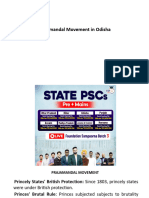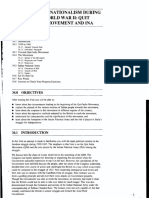Role of Press in India
Role of Press in India
Uploaded by
Jhamnani ChandniCopyright:
Available Formats
Role of Press in India
Role of Press in India
Uploaded by
Jhamnani ChandniCopyright
Available Formats
Share this document
Did you find this document useful?
Is this content inappropriate?
Copyright:
Available Formats
Role of Press in India
Role of Press in India
Uploaded by
Jhamnani ChandniCopyright:
Available Formats
Role of Press in India's Struggle for Freedom
At the time of the first war of independence, any number of papers were in operation in the country. Many of these like Bangadoot of Ram Mohan Roy, Rastiguftar of Dadabhai Naoroji and Gyaneneshunadvocated social reforms and thus helped arouse national awakening. It was in 1857 itself that Payam-e-Azadi started publication in Hindi and Urdu, calling upon the people to fight against the British. The paper was soon confiscated and anyone found with a copy of the paper was presecuted for sedition. Again, the first hindi daily, Samachar Sudhavarashan, and two newspapers in Urdu and Persian respectively, Doorbeen and Sultan-ul-Akbar, faced trial in 1857 for having published a 'Firman' by Bahadur Shah Zafar, urging the people to drive the British out of India. This was followed by the notroius Gagging Act of Lord Canning, under which restrictions were imposed on the newspapers and periodicals. Notable Role In the struggle against the British, some newspapers played a very notable role. This included theHindi Patriot! Established in 1853, by the author and playwright, Grish Chandra Ghosh, it became popular under the editorship of Harish Chandra Mukherjee. In 1861, the paper published a play, "Neel Darpan" and launched a movement against the British, urging the people to stop cultivating the crop for the white traders. This resulted in the formation of a Neel Commission. Later, the paper was taken over by Ishwar Chandra Vidyasagar. The paper strongly opposed the Government's excesses and demanded that Indians be appointed to top government posts. The Indian Mirror was the other contemporary of this paper which was very popular among the reading public. Yet another weekly, Amrita Bazar Patrika which was being published from Jessore, was critical of the government, with the result that its proprietors faced trial and conviction. In 1871, the Patrika moved to Calcutta and another Act was passed to supress it and other native journals. Marathi Press Mahadev Govind Rande, a leading leader of Maharashtra, used to write in Gyan Prakash as well as inIndu Prakash. Both these journals
helped awaken the conscience of the downtrodden masses. Another Marathi weekly, Kesari was started by Tilak from January 1, 1881. He aIongwith Agarkar and Chiplunkar started another weekly journal, Mratha in English. The Editor of the 'Daccan Star' Nam Joshi also joined them and his paper was incorporated with Maratha. Tilak and Agarkar were convicted for writings against the British and the Diwan of Kolhapur. Tilak's Kesari became one of the leading media to propagate the message of freedom movement. It also made the anti-partition movement of Bengal a national issue. In 1908, Tilak opposed the Sedition ordinace. He was later exiled from the country for six years. Hindi edition of Kesari was started from Nagpur and Banaras. Press and the First Session of Congress The Editors commanded a very high reputation at the time of the birth of the Indian National Congress. There were many Congress Presidents who had either been the editors or had started the publication of one or the other newspapers. In this context, particular mention may be made of Ferozeshah Mehta who had started the Bombay Chronide and Pandit Madan Mohan Malaviya who edited daily, Hindustan. He also helped the publication of Leader from Allahabad. Moti Lal Nehru was the first Chairman of the Board of Directors of the leader. Lala Lajpat Rai inspired the publication of three journals, the Punjabi, Bandematram and the People from Lahore. During his stay in South Africa, Gandhiji had brought out Indian Opinion and after settling in India, he started the publication of Young India; Navjeevan, Harijan, Harijan Sevak and Harijan Bandhu. Subash Chandra Bose and C.R. Das were not journalists but they acquired the papers like Forward and Advance which later attained national status. Jawaharlal Nehru founded the National Herald. Revolutionary Movement and the Press The first to be mentioned in this context is Yugantarpublication of which was started by Barindra Kumar Ghosh who edited it also. After Yugantar, it was Vandematram that played a significant role in the freedom struggle. This journal was established by Subodha Chandra Malik, C.R. Das and Bipin Chandra Pal on August 6, 1906. So far as the Hindi papers were concerned, they looked to government for support for some time. Bhartendu Harish Chandra was the first to start a journal Kavi Vachan Sudha in 1868. Its policy was to give vent to the miseries of the people of India.
The government aid to journals like Kavi Vachan Sudha was stopped for publishing what was objectionable from the government point of view. The Bharat-Mitra was a famous Hindi journal of Calcutta which started its publication on May 17, 1878 as a fortnighly. It contributed a lot in propagating the cause of freedom movement. The journal exposed the British conspiracy to usurp Kashmir. Several other papers published from Calcutta which played an important role in freedom struggle included Ambika Prasad Vajpayee's Swantrtmtra, Ramanand Chatterjee's Modern Review' in English, Pravasi Patra' in Bengali and Vishal Bharat in Hindi. . Amritlal Shet brought out the Gujarati journal Janmabhumi which was an organ of the people of the princely states of Kathiawad, but it became a mouthpiece of national struggle. Similarly another Gujarati journalSaanjvartman played a prominent role under the editorship of Sanwal Das Gandhi, who played a very significant role in the Quit India Movement in 1942. It was soon after independent formed a parallel Government in Junagarh and forced the Nawab of Junagarh to leave the country. The three editors of the Sindhi journal Hindi Jairam Das Daulatram, Dr. choithram Gidwani and Hiranand karamchand, were arrested, their press closed and the property of the paper confiscated. In Bihar the tradition of national newspapers was carried forward by Sachidanand Sinha, who had started the publication of Searchlight under the editorship of Murtimanohar Sinha. Dev Brat Shastri started publication of 'Nav Shakti and Rashtra Vani'. The weekly yogi and the Hunkar' also contributed very much to the general awakening.
You might also like
- Essential Soft Skills for Lawyers: What They Are and How to Develop ThemFrom EverandEssential Soft Skills for Lawyers: What They Are and How to Develop ThemNo ratings yet
- Most Repeated Mcqs in PPSC Past PapersDocument3 pagesMost Repeated Mcqs in PPSC Past PapersHaseeb Hassan89% (37)
- Some Important Facts About Framing of Indian ConstitutionDocument3 pagesSome Important Facts About Framing of Indian ConstitutionRajatAgrawalNo ratings yet
- Bal Gangadhar Tilak: Why in NewsDocument3 pagesBal Gangadhar Tilak: Why in NewsSaurabh Yadav100% (1)
- Accession of Pricely States and Reorganisation of The StatesDocument66 pagesAccession of Pricely States and Reorganisation of The StatesAadhitya NarayananNo ratings yet
- Battle of PlasseyDocument201 pagesBattle of PlasseywashimNo ratings yet
- The Unification of Italy: Prof. Abha TrivediDocument5 pagesThe Unification of Italy: Prof. Abha TrivediNigel Kundi JowaNo ratings yet
- Defamation ProjectDocument19 pagesDefamation ProjectLAKSHMANA SRAVANNo ratings yet
- Rajiv Gandhi Biography: Quick FactsDocument6 pagesRajiv Gandhi Biography: Quick FactsBalrajGoulikarNo ratings yet
- Overview of Bal Gangadhar Tilak ..: By: A.Meenakshi - Yadav Class 10Document8 pagesOverview of Bal Gangadhar Tilak ..: By: A.Meenakshi - Yadav Class 10Meenakshi YadavNo ratings yet
- 1909 Council Act 123456Document19 pages1909 Council Act 123456Bhuvaneswari Ram MotupalliNo ratings yet
- The Colonial ConstitutionDocument209 pagesThe Colonial ConstitutionYash GajmalNo ratings yet
- Battle of Plassey & BuxarDocument5 pagesBattle of Plassey & BuxarGouravNo ratings yet
- Charter Act 1833: The Twenty Year Intervening Between The Acts of 1813 and 1833 Witnessed Great Changes in EnglandDocument3 pagesCharter Act 1833: The Twenty Year Intervening Between The Acts of 1813 and 1833 Witnessed Great Changes in EnglandHidayath Ullah100% (1)
- Unjust Enrichment and Contract LawDocument21 pagesUnjust Enrichment and Contract LawShraddhaNo ratings yet
- Government of India Act 1919Document20 pagesGovernment of India Act 1919Ojasvi Arora100% (2)
- Sociology Project 3rd SemDocument18 pagesSociology Project 3rd SemDilip Jani100% (1)
- 04 NotesDocument5 pages04 NotesTapasya AryaNo ratings yet
- Indian FeudalismDocument4 pagesIndian FeudalismShreya SinghNo ratings yet
- Rattan Chand Hira Chand VDocument6 pagesRattan Chand Hira Chand VBishwajeet JhaNo ratings yet
- Paper 1 Dse-A-1 Sem - 5: History of BENGAL (c.1757-1905)Document3 pagesPaper 1 Dse-A-1 Sem - 5: History of BENGAL (c.1757-1905)Bidyut Mandal100% (1)
- History II Role of Revolutionaries in Indian Freedom Struggle FINAL FINALDocument22 pagesHistory II Role of Revolutionaries in Indian Freedom Struggle FINAL FINALPrabhakar SharmaNo ratings yet
- Social and Political PhilosophyDocument10 pagesSocial and Political PhilosophySarita singhNo ratings yet
- History ProjectDocument13 pagesHistory ProjectKonark SinghNo ratings yet
- Torts Case CommentDocument10 pagesTorts Case Commenttarun chhapolaNo ratings yet
- Fundamental DutiesDocument6 pagesFundamental DutiesAnonymousNo ratings yet
- The Charter Act of 1853 Features Significance UPSC NotesDocument2 pagesThe Charter Act of 1853 Features Significance UPSC NotesVirendra PratapNo ratings yet
- M. S. Anirudhan Vs The Thomco's Bank LTDDocument6 pagesM. S. Anirudhan Vs The Thomco's Bank LTDAnkit JindalNo ratings yet
- Relationship Between Fundamental Rights and DPSP.Document10 pagesRelationship Between Fundamental Rights and DPSP.Faraz KhanNo ratings yet
- The Lal Bahadur Shastri 19.10.16Document170 pagesThe Lal Bahadur Shastri 19.10.16Sathyanarayana Rao Turlapati0% (1)
- Bal Gangadhar TilakDocument27 pagesBal Gangadhar Tilakchaaya20100% (1)
- Ethics - IA - 2 - Hind Swaraj - BookReviewDocument9 pagesEthics - IA - 2 - Hind Swaraj - BookReviewMokshha SharmaNo ratings yet
- TulassamaDocument13 pagesTulassamaSarthika Singhal Sarthika Singhal100% (1)
- Communalism Concept of Communalism: Communalism Is An Ideology Which States That Society IsDocument3 pagesCommunalism Concept of Communalism: Communalism Is An Ideology Which States That Society IsTanya JainNo ratings yet
- Agrarian Reforms in IndiaDocument14 pagesAgrarian Reforms in IndiafoodproNo ratings yet
- RTI & JudiciaryDocument13 pagesRTI & JudiciaryMamatha RangaswamyNo ratings yet
- Delhi Sultanate AdministrationDocument22 pagesDelhi Sultanate AdministrationKetan KhairwalNo ratings yet
- Forest Act HistoryDocument17 pagesForest Act Historykhantariq12100% (1)
- The Mauryan Empire (322bc To 188bc)Document2 pagesThe Mauryan Empire (322bc To 188bc)api-3737960100% (1)
- The Vice President of IndiaDocument25 pagesThe Vice President of IndiaAdhishPrasadNo ratings yet
- History: Writings On The Partition of India Sub Topic: - Train To Pakistan-Khushwant Singh'Document16 pagesHistory: Writings On The Partition of India Sub Topic: - Train To Pakistan-Khushwant Singh'19140 VATSAL DHARNo ratings yet
- History PDFDocument19 pagesHistory PDFAbdul HamedNo ratings yet
- Unit 8 Bal Gangadhar Tilak: StructureDocument14 pagesUnit 8 Bal Gangadhar Tilak: StructureKUMAR LAVNo ratings yet
- Battle of BuxarDocument2 pagesBattle of BuxarVivek SinghNo ratings yet
- Battle of Plassey & BuxarDocument5 pagesBattle of Plassey & BuxarPrateek SinghNo ratings yet
- The National Law Institute University, Bhopal: Prof. Dr. Uday Pratap SinghDocument14 pagesThe National Law Institute University, Bhopal: Prof. Dr. Uday Pratap SinghanuragrajputNo ratings yet
- Akbars Religious Policy PDFDocument8 pagesAkbars Religious Policy PDFAbhinav TripathiNo ratings yet
- Poona PactDocument43 pagesPoona PactSourav BasuNo ratings yet
- Montford ReformsDocument8 pagesMontford ReformsSuyash S LeleNo ratings yet
- Judicial System of East India CompanyDocument14 pagesJudicial System of East India CompanymahuanarayanNo ratings yet
- Regulating Act 1773Document9 pagesRegulating Act 1773BhoomiNo ratings yet
- Land Law Notes-1Document48 pagesLand Law Notes-1Bhavapriya SreenivasNo ratings yet
- Conclusion Political Development Following Integrationinto The Indian Union: The Interim PeriodDocument24 pagesConclusion Political Development Following Integrationinto The Indian Union: The Interim PeriodBashan RyndongNo ratings yet
- Legal Institutions in Mediaval IndiaDocument22 pagesLegal Institutions in Mediaval IndiaPrakhar Deep83% (6)
- 18th Century Polity-Rakhi System, Gurmata, Dal KhalsaDocument13 pages18th Century Polity-Rakhi System, Gurmata, Dal KhalsaSandhya Upmanyu100% (1)
- Mrunal (Land Reforms) British Land Tenure System - Features, Consequences of Permanent Settlement, Ryotwari, Mahalwari PrintDocument14 pagesMrunal (Land Reforms) British Land Tenure System - Features, Consequences of Permanent Settlement, Ryotwari, Mahalwari PrintAbhishek TomarNo ratings yet
- In The Matter of Article 21, 25, 29 of The ConstitutionDocument26 pagesIn The Matter of Article 21, 25, 29 of The ConstitutionRaghav SenguptaNo ratings yet
- The Impact of British Rule On The Socio Economic Conditions of Indian WomenDocument9 pagesThe Impact of British Rule On The Socio Economic Conditions of Indian WomenChitra NairNo ratings yet
- Dr. Ram Manohar Lohiya National Law University, Lucknow: Mountbatten Plan and Independence Act of 1947Document15 pagesDr. Ram Manohar Lohiya National Law University, Lucknow: Mountbatten Plan and Independence Act of 1947Irul SrivastavaNo ratings yet
- Evolution of Judicial Systems Under East India CompanyDocument11 pagesEvolution of Judicial Systems Under East India CompanynaimenimNo ratings yet
- Liberty After Freedom: A History of Article 21, Due Process and the Constitution of IndiaFrom EverandLiberty After Freedom: A History of Article 21, Due Process and the Constitution of IndiaNo ratings yet
- Quaid e AzamDocument8 pagesQuaid e AzamFawad hameedNo ratings yet
- Making of The Indian ConstitutionDocument11 pagesMaking of The Indian ConstitutionShoaib AktherNo ratings yet
- Ch.2 PAKS1119Document7 pagesCh.2 PAKS1119qaifmughal111100% (1)
- PAK301 MCQs Mids 2024 Mam Mehwish-1Document33 pagesPAK301 MCQs Mids 2024 Mam Mehwish-1Amir MaqbolNo ratings yet
- Book A Leadership OdysseyDocument3 pagesBook A Leadership OdysseyWaqas AzizNo ratings yet
- Muslim League ICSE Class 10 HistoryDocument8 pagesMuslim League ICSE Class 10 Historyshreyammandal001No ratings yet
- Modern India-2 2022 1010 PDFDocument33 pagesModern India-2 2022 1010 PDFAnkit RanaNo ratings yet
- Bhagat SinghDocument2 pagesBhagat SinghThalapathy TravelsNo ratings yet
- History Question Paper 2024Document3 pagesHistory Question Paper 2024ayanjehangir17No ratings yet
- Swadeshi Movement PDFDocument9 pagesSwadeshi Movement PDFKarthikeyanNo ratings yet
- History Chap 6Document17 pagesHistory Chap 6ayan031077No ratings yet
- History ProjectDocument20 pagesHistory ProjectAdhipatya SinghNo ratings yet
- Nationalism in IndiaDocument59 pagesNationalism in Indialegendary playerNo ratings yet
- Emergence of Indian National CongressDocument7 pagesEmergence of Indian National CongressSidharth SasankanNo ratings yet
- Viceroys of IndiaDocument4 pagesViceroys of IndiaRavi SharmaNo ratings yet
- History of Pakistan MCQs Notes PDFDocument7 pagesHistory of Pakistan MCQs Notes PDFShamshad Ali Rahoojo50% (2)
- Pakistan Kaisay Bana (Volume 2)Document765 pagesPakistan Kaisay Bana (Volume 2)TehqeeqNo ratings yet
- 4375135-WS - No2. Class.X. Nationalism in India (Hist) Preetha.J .2024-25Document3 pages4375135-WS - No2. Class.X. Nationalism in India (Hist) Preetha.J .2024-25Farzana FatimaNo ratings yet
- List of Governors-General of India - WikipediaDocument15 pagesList of Governors-General of India - WikipediaSaket Raj100% (1)
- Summer Vacation Holiday Homework Class VIII EnglishDocument9 pagesSummer Vacation Holiday Homework Class VIII EnglishratnapathakNo ratings yet
- Difference Between The Non-Cooperation Movement and Civil Disobedience MovementDocument2 pagesDifference Between The Non-Cooperation Movement and Civil Disobedience MovementKing SantoshNo ratings yet
- Indian Independence 1857-1947Document15 pagesIndian Independence 1857-1947Jaskirat SinghNo ratings yet
- Vinebre AcDocument2 pagesVinebre Acarun aryaNo ratings yet
- Prajamandal Mandal in OdishaDocument15 pagesPrajamandal Mandal in Odishagaganpradhan81705No ratings yet
- Emergence of Pakistan - MCQsDocument10 pagesEmergence of Pakistan - MCQsHassan KhanNo ratings yet
- Time Line Between 1857 To 1947Document8 pagesTime Line Between 1857 To 1947Safdar Hayat KhaksarNo ratings yet
- The Making of The National Movement Worksheet 2Document2 pagesThe Making of The National Movement Worksheet 2vd2pmrvsc4No ratings yet
- An Agent of BritishDocument5 pagesAn Agent of BritishNithyananda PrabhuNo ratings yet
- Ignou History 4Document118 pagesIgnou History 4Savy ChaudharyNo ratings yet




